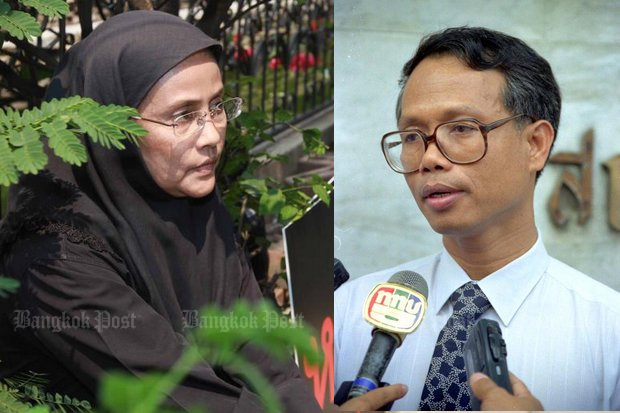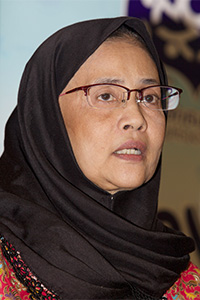
It was 8.30pm on March 12, 2004, when Somchai Neelapaijit got out of his car to check the damage to his vehicle after it was hit by another car on Ramkhamhaeng Road.
The lawyer was seen being bundled into that car, which immediately sped away from the crash scene just a stone's throw from a police station.
Another man took Mr Somchai's car and followed in the same direction. No one has seen Mr Somchai since.
In courtroom number 809 on Dec 29, 2015 -- at 9.30am -- the Supreme Court acquitted five police officers charged with abduction and thievery, citing weak evidence that lacked verification from the proper authorities. By then, the case had dragged on for 11 years and nine months.
The 2015 ruling, which also rejected a petition from the family to be a co-plaintiff, effectively set a norm that the families of those forcibly disappeared cannot represent them as "there was no evidence that the missing person was dead or had sustained serious enough injuries to prevent him representing himself in the case".
That ruling is based on the Criminal Code Section 5(2), that treated Mr Somchai as the only affected person. While his body remains missing, he is considered a living person, and since there is no evidence he has been seriously injured preventing him appearing in court, Mr Somchai is obliged to turn up in court to pursue the case. In accordance with the law, his family was not a damaged party. In short, this kind of case cannot be pursued in the absence of the damaged party in strict legal terms.
If we are to interpret the ruling by the letter, this means Mr Somchai was abducted by a group of men, but since his body has not been recovered, he is not dead, and without evidence he is not seriously injured, his family cannot do anything on his behalf. Simply put, there is no damaged party in this case because Mr Somchai has failed to show up.
Speaking from the experience of a de facto victim, it's extremely difficult to pursue the case against state officers. Putting aside threats and intimidation, our attempts to access the justice system were and are faced with a myriad of obstacles. The 2015 ruling which means there are no damaged party, no wrongdoers, no culprits, is just a dead-end for us. The family has no access to a rehabilitation process. The ruling reinforces a culture of impunity when state officials are involved. This is a major flaw in our justice system, in which state officials involved in deadly abduction can get away with the crime.
Not long after the 2015 verdict, the Department of Special Investigation (DSI) told our family it had decided to close the case as "no culprits could be found".
Due to pressure from international human rights advocacy groups and (UN Working Group on Enforced or Involuntary Disappearance -- UN WGEID) as well as the victims' families, the government on January 2012 signed the International Convention for the Protection of All Persons from Enforced Disappearance (CED). In 2016, the cabinet endorsed the ratification of the convention, assigning the Justice Ministry to draft the Torture and Enforced Disappearance Prevention and Suppression Bill.
Yet, progress on this matter has been hindered by the coup-installed National Legislative Assembly, which does not care much about public participation, nor input from victims' families in deliberating the bill. On top of that, I have the impression that the NLA is vetting the bill with fears and concerns that it may be used to target state officials and that may obstruct the work of state authorities. With such concerns, some elements in the NLA may have tried to insert mechanisms that could better protect the authorities, rather than human rights. This means the law may not really help victims nor their families. In other words, the law may be watered down so that it does not really prevent torture and enforced disappearance.
In my opinion, the legislature must respect a crucial clause in the UN convention that enforced disappearance is a continuous crime and has no statute of limitations. The law must endorse the rights of the victims' families to gain access to justice. The state has the duty to work until the fate of all victims becomes known, even if such a crime took place before the law becomes effective.
Mr Somchai is not the only human rights defender to fall victim to forced disappearance. There were many rights activists being killed, assaulted or harmed in various ways at the time when Mr Somchai was killed and almost no culprits were held responsible for the heinous crimes. According to UN reports, the country has seen more than 80 well-documented cases of unresolved torture and enforced disappearances over the past 15 years.
If the pursuit for justice was a road, my family and I were almost at the end of it. But we have encountered numerous obstacles and hardships over the past 15 years that have blocked us from truth and justice. For myself, even though evidence in Mr Somchai's case is more than enough and so clear that I can see the faces of the culprits, it has been deemed useless.
As long as our justice system cannot punish the culprits, merely because they are state officials, I, like so many in this society, will remain a victim of a flawed system. While those in power continue to remain indifferent to the hardship of people deprived of rights and justice, how can we look into the eyes of the youth, those of the new generations and offer them hope?
Angkhana Neelapaijit is wife of Somchai Neelapaijit and a human rights defender.
